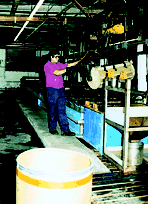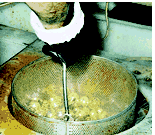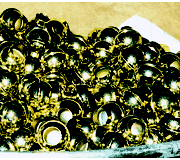Simulated Brass Process Eliminates Cyanide
Star Plating introduced a new post-plating process that has helped the company and its customers...
Just about the only way to plate brass well is to use a cyanide solution. So when William Roeder, vice president and general manager of Star Plating in New Bedford, Massachusetts, decided to eliminate cyanide as much as possible, he had to first convince his customers that a new process could give them the look of brass without the cyanide.
These customers included manufacturers of curtain rod hardware, accessory parts for cedar shoe trees, deluxe coat hanger hooks, decorative screws and rings for bird feeders. All of these products end up in the discriminating hands of the general consumer, so the color and finish quality had to be perfect.
Star already had a reputation for quality barrel plating of steel hardware, stampings and castings with zinc, nickel, copper, brass and matte tin. Post plating operations included bright, clear or blue bright, yellow, olive and black chromates. The plating is done to commercial, military and automotive specifications.
The company, which Mr. Roeder and his brother-in-law, John Thompson, purchased 10 years ago from the original owner, has 10 zinc lines with a total of 30,500 gal of acid chloride zinc. These lines include five Stevens' Automatics with oblique barrels and five horizontal barrel lines with manually operated overhead hoists.
With these lines, Star Plating Company operates 24 hours per day, six days a week with two shifts. Star plates approximately 250,000 to 300,000 lbs of material per week, with a normal two-day turnaround cycle.
The company introduced its simulated-brass post-zinc-plating operation in 1989. The steel parts are zinc plated and finished off-line according to Table I. This simulated brass post-plating operation, which is acid-chloride-based, allows Star to plate parts with severe dragout problems that would have been unsuitable for its cyanide-based brass plating operation. By doing the chromating and dying off-line, the company has more control over the final finish (appearance).
In addition to the new simulated-brass process, Star reduced cyanide use by consolidating three cyanide plating lines into one nickel/copper/brass plating line. The company also changed from cyanide chemicals in powder form to liquid to improve solubility.
The new post-plating brass-simulated finish converted some of the demand for cyanide brass plating to zinc plating. The combined result of the operational change and the new process was a 30 pct reduction in cyanide use. This subsequently resulted in reduced toxic emissions in the company's effluent and sludge and the near elimination of the cyanide sludge waste stream.
The simulated brass produced using Heatbath Brass Dye No. 1 is followed by a water-soluble clear coat. The final coating reduces iridescence and provides abrasion protection. The finished part provides better salt spray resistance and longer shelf life than brass plating, which tends to tarnish.
The simulated brass finish is "easier" to achieve on curved parts; however, Star Plating has perfected it on larger flat hardware. Star's achievement came through its partnership with Chemical Finishing Company, which was recently acquired by Heatbath Corp., Springfield, Massachusetts. Star and its supplier developed several proprietary plating processes unique to Star's needs. Many of these processes have since become standard chemistries offered by Heatbath. The zinc plating and simulated brass dye were just two of the projects.
Heatbath continues to work with Star by performing weekly Hull cell tests and titrations of the plating solutions. Heatbath's zinc chemistry is forgiving and requires no filtration or cooling. The simulated brass solution temperature is maintained at approximately 100F, although it is operational anywhere from 80 to 110F. The pH is maintained at 4 to 7. The plating operator controls the chromate and dye solutions by experience and makes additions necessary to maintain color consistency.
The supplier has also helped Star with pollution prevention and reduction. In 1995, the company received the Governor's Award for Outstanding Achievement in Toxics Use Reduction in Massachusetts. The basis for the award included five projects:
1.Trichloroethylene cleaner in tin fusing was eliminated and replaced with an aqueous cleaner. Star subsequently eliminated all ODP and solvent-based cleaners.
2.Star began purchasing zinc brightener in 350-gal totes rather than 55-gal drums. Totes are locked and brightener is issued to each of ten plating lines twice in 24 hours. Brightener use has been reduced 32 pct.
3.Three cyanide plating lines were consolidated and a simulated-brass post-plating process introduced.
4.Star reuses about 70 pct of its effluent for production cleaning rinses, and a custom-designed spray rinse system has been introduced. Water use has decreased 71 pct since 1985, and the amount of metals in the effluent has been reduced 87 pct. Star has reduced water consumption from 75 million gal/year to 14 to 16 million gal/year.
5.Generation and disposal of metal hydroxide sludge have been reduced 75 pct by reducing dragout and using a sludge dryer.
The company achieved significant results with modest expenditures. And these modest expenditures resulted in considerable economic savings.
Star Plating knew that to stay in business it had to implement serious pollution prevention techniques, which included reducing cyanide throughout the entire facility. The company also realized that to stay in business it had to provide innovative new processes to keep its customers happy enough to return. The simulated-brass post-zinc-plating process helped Star achieve both.
TABLE I—Simulated Brass Process
| Process Step | Tank Make-Up | Chemical Name | Approx. Time |
| 1. Clean in an alkaline soak cleaner at 140F | 8-10 oz/gal | 5-10 min (or as required) |
|
| 2. Rinse | |||
| 3. Clean in dilute hydrochloric acid, ambient temperature |
20 pct solution | 5-10 min (or as required) |
|
| 4. Rinse | |||
| 5. Zinc plate to commercial thickness in acid chloride solution at ambient temp. |
Zn metal: 2.5 oz/gal Ammonium chloride: 5.5 oz/gal pH: 5.5 |
Lustra-Zinc 10 Star Mix |
45 min (or as required) |
| 6. Rinse | |||
| 7. Hand dip in chromate solution | 2-3 pct solution | Duracoat Star Blue | |
| 8. Rinse | |||
| 9. Hand dip in brass dye | approx. 0.5 oz/gal | Brass Dye No. 1 | |
| 10. Rinse | |||
| 11. Hand dip in clear coat | ~ 2 pct solution | Laq Dip or Duraseal NC | |
| 12. Spin dry in centrifugal steam dryer at 140F |

|

|
5 min (or as req'd to thoroughly dry) |
Related Content
NASF/AESF Foundation Research Project #120: Electrochemical Destruction of Perfluorooctanesulfonate in Electroplating Wastewaters – January – December 2023
This NASF-AESF Foundation research project report covers quarterly reporting for the year 2023 at the University of Illinois at Chicago. The objective of this work is to utilize a cost-effective reactive electrochemical membrane (REM) for the removal of PFAS from synthetic electroplating wastewater. Discussed here are the oxidation of PFOA with three different catalysts, development of a method for detecting PFAS, as well as work on 6:2-fluorotelomersulfonic acid (6:2 FTS) and electrodeposited bismuth/tin oxide catalysts.
Read MoreTop 5 Areas to Consider Automation of Plating Operations
Automation for finishing operations can lead to improvements in process time, repeatability and consistency of quality. Yet, processes that make sense to explore for these operational efficiencies may not always be readily apparent.
Read MoreHubbard-Hall Acquires BioConversion Technology
The acquisition adds experience and biologics to the AquaPure product line.
Read MoreNASF/AESF Foundation Research Project #121: Development of a Sustainability Metrics System and a Technical Solution Method for Sustainable Metal Finishing - 15th Quarterly Report
This NASF-AESF Foundation research project report covers the twelfth quarter of project work (October-December 2023) at Wayne State University in Detroit. In this period, our main effort focused on the development of a set of Digital Twins (DTs) using the Physics-Informed Neural Network (PINN) technology with application on parts rinsing simulation.
Read MoreRead Next
Education Bringing Cleaning to Machining
Debuting new speakers and cleaning technology content during this half-day workshop co-located with IMTS 2024.
Read MoreDelivering Increased Benefits to Greenhouse Films
Baystar's Borstar technology is helping customers deliver better, more reliable production methods to greenhouse agriculture.
Read MoreA ‘Clean’ Agenda Offers Unique Presentations in Chicago
The 2024 Parts Cleaning Conference, co-located with the International Manufacturing Technology Show, includes presentations by several speakers who are new to the conference and topics that have not been covered in past editions of this event.
Read More


























